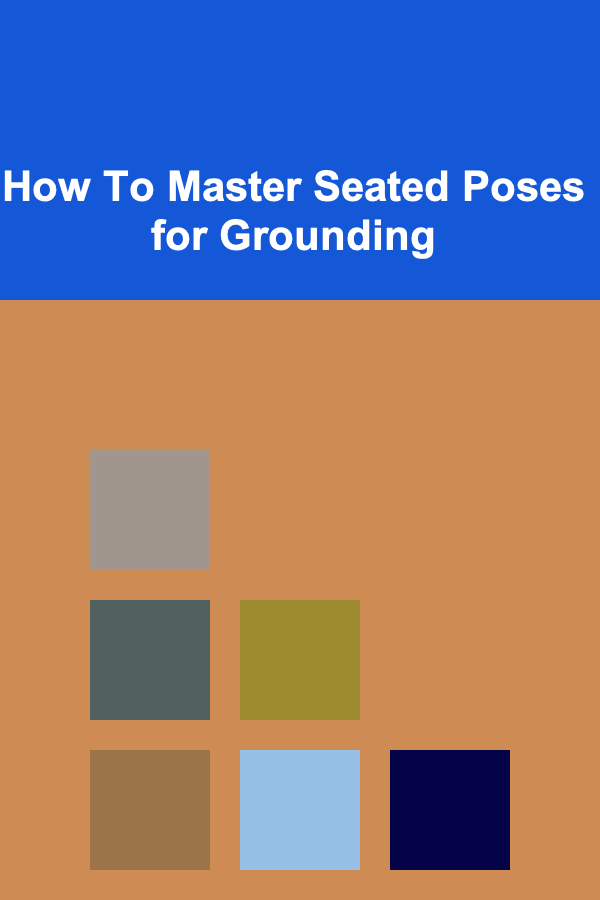
How To Master Seated Poses for Grounding
ebook include PDF & Audio bundle (Micro Guide)
$12.99$8.99
Limited Time Offer! Order within the next:

Grounding is a concept often discussed in various practices, from yoga to meditation, mindfulness, and even some forms of therapy. It refers to the act of connecting deeply to the Earth, feeling stable, calm, and centered. Grounding practices, especially in the context of physical postures, can help bring balance, relieve stress, and improve mental clarity. One of the most effective ways to achieve grounding is through seated poses. Seated poses help activate the body's energy, engage the mind, and promote a feeling of rootedness and stability.
In this article, we'll explore the different aspects of seated poses for grounding, how to approach them, and why they are such a powerful tool in fostering a sense of stability and calm.
Understanding Grounding
Before delving into the specifics of seated poses, it's important to understand the concept of grounding itself. Grounding, also known as "earthing" in some practices, is the act of reconnecting to the Earth, both physically and mentally. When we are grounded, we are more in tune with our bodies and less distracted by external stimuli. Grounding helps us release tension, cultivate a deep sense of calm, and center ourselves in the present moment.
Grounding can be experienced in many ways. Walking barefoot on grass, touching a tree, or sitting on the Earth are all practices that physically connect you to the ground. But it is not just physical; grounding also affects the mind. When you practice grounding, you feel centered, more aware of your body, and aligned with the present moment.
For many, seated poses are an accessible and effective way to ground themselves. When done correctly, seated postures can help connect your body to the Earth while simultaneously calming the mind.
The Benefits of Seated Poses
Seated poses offer numerous benefits, both physically and mentally. Here are a few key advantages:
1. Improved Posture
Seated poses require you to sit upright, which can help improve your posture over time. Poor posture, especially from sitting for long periods, can lead to back pain, muscle tension, and discomfort. By practicing seated poses that encourage alignment and stability, you can counteract these negative effects.
2. Enhanced Focus and Clarity
Seated poses, particularly when combined with mindful breathing, create a natural setting for focus and concentration. The act of sitting still in a stable position encourages the mind to slow down, allowing for clearer thinking and greater mental clarity.
3. Increased Flexibility and Strength
Many seated poses target key areas of the body, including the hips, thighs, and lower back. Regular practice can lead to greater flexibility in these regions, as well as improved strength, particularly in the core and legs.
4. Stress Reduction
Grounding through seated poses has been shown to reduce stress levels. By focusing on the breath and maintaining a stable seat, you can engage the parasympathetic nervous system, which promotes relaxation and reduces stress.
5. Emotional Balance
Seated poses can help balance emotions, especially when practiced with mindfulness. When we feel grounded, we are less likely to be tossed around by emotional fluctuations. By cultivating a solid foundation in seated postures, we can foster a greater sense of emotional stability.
Key Seated Poses for Grounding
There are many seated poses in yoga and other movement practices that encourage grounding. Let's take a look at a few of the most effective ones:
1. Sukhasana (Easy Pose)
Sukhasana, often referred to as Easy Pose, is one of the simplest seated postures in yoga. It's accessible to people of all levels and is often used as a starting point for meditation or breathing exercises.
How to do it:
- Sit on the floor with your legs extended in front of you.
- Cross your legs at the ankles, placing the soles of your feet against each other.
- Sit tall with your spine aligned, shoulders relaxed, and hands resting on your knees or in your lap.
- Close your eyes and focus on your breath, allowing it to slow and deepen.
Why it's grounding:
Sukhasana is grounding because it creates a stable base with the legs crossed in front of you. The posture helps to establish a sense of calm and balance, while the relaxed body fosters a deeper connection with the Earth.
2. Vajrasana (Thunderbolt Pose)
Vajrasana, or Thunderbolt Pose, is another excellent seated position for grounding. It involves sitting on your heels with your legs bent beneath you.
How to do it:
- Kneel on the floor and sit back on your heels.
- Keep your knees together and your feet flat on the floor.
- Sit up straight with your hands resting on your thighs.
- Relax your shoulders and breathe deeply.
Why it's grounding:
Vajrasana allows you to connect directly to the Earth through the thighs and pelvis. The posture helps stabilize the lower body while promoting a deep sense of stillness and tranquility.
3. Padmasana (Lotus Pose)
Padmasana, or Lotus Pose, is a traditional yoga pose that is deeply rooted in meditation practices. This advanced pose involves crossing both legs in a way that the feet rest on the opposite thighs.
How to do it:
- Begin by sitting on the floor with your legs extended in front of you.
- Cross your right foot over your left thigh, bringing the sole of the foot to face upward.
- Then, cross your left foot over your right thigh, bringing the sole of the foot to face upward as well.
- Keep your spine long and straight, and place your hands on your knees or in a mudra of your choice.
- Focus on your breath and maintain stillness.
Why it's grounding:
Padmasana helps to align the spine and activate the energy centers of the body. The connection between the feet and the thighs helps foster a strong grounding effect while simultaneously encouraging mental clarity and focus.
4. Dandasana (Staff Pose)
Dandasana, or Staff Pose, is a simple seated pose that involves sitting with your legs extended straight in front of you. It is often used as a preparatory pose for other asanas.
How to do it:
- Sit on the floor with your legs extended straight in front of you.
- Press your thighs firmly into the floor and flex your feet.
- Keep your spine tall and your shoulders relaxed.
- Place your hands on the floor beside your hips, pressing down to help lift your chest.
Why it's grounding:
Dandasana helps to establish a solid and stable foundation by engaging the legs and feet. It encourages alignment in the spine and promotes a sense of rootedness and strength.
5. Baddha Konasana (Bound Angle Pose)
Baddha Konasana, or Bound Angle Pose, is a seated pose that involves bringing the soles of the feet together and gently opening the hips.
How to do it:
- Sit with your legs extended in front of you.
- Bring the soles of your feet together, allowing your knees to fall open to the sides.
- Hold your feet with your hands, and keep your back straight.
- Allow your hips to open gently while taking deep, steady breaths.
Why it's grounding:
This pose opens the hips and encourages a deep connection to the floor through the feet and legs. The act of sitting upright while gently stretching the hips and inner thighs promotes a sense of stability and calm.
Tips for Mastering Seated Poses
1. Focus on Your Breath
The breath is a powerful tool when it comes to grounding. Deep, mindful breathing helps anchor the mind and body in the present moment. Focus on taking slow, deep breaths through the nose, allowing the breath to fill the lungs and expand the diaphragm.
2. Engage Your Core
While seated poses are often relaxing, it's important to engage your core muscles to maintain a stable and upright posture. Gently draw your navel toward your spine to activate the core, which will help support the spine and prevent slouching.
3. Use Props for Comfort
If you find it difficult to sit comfortably in certain seated poses, consider using props such as cushions, blankets, or yoga blocks. These props can help elevate the hips, support the knees, or provide extra cushioning for the body, making the pose more accessible.
4. Start with Short Sessions
If you're new to grounding practices or seated poses, start with shorter sessions. Begin by holding a pose for 2--3 minutes and gradually increase the time as your body becomes more comfortable. It's important to listen to your body and avoid pushing yourself too hard.
5. Cultivate Mindfulness
While practicing seated poses, cultivate mindfulness by paying attention to your body's sensations, thoughts, and feelings. Be present with your breath and notice any areas of tension or discomfort. Mindfulness will help you deepen your grounding experience and enhance the benefits of the practice.
Conclusion
Mastering seated poses for grounding is a powerful tool for cultivating stability, calm, and focus in your life. Whether you're practicing yoga, meditation, or simply taking a moment for yourself, seated poses can help you connect to the Earth and foster a sense of peace within. By incorporating these poses into your daily routine, you'll not only improve your physical posture and flexibility but also experience greater mental clarity and emotional balance.
The key to mastering seated poses is consistency, patience, and mindfulness. Start with simple poses and gradually explore more advanced ones as your body becomes stronger and more flexible. With time, you'll deepen your connection to the Earth and discover the grounding effects that these poses can bring to your life.

How to Organize Books by Age and Interest
Read More
How to Organize Your Car with Practical Storage Solutions
Read More
How to Save Money on Travel and Still Enjoy Your Trips
Read More
How to Understand the Genetics of Skin Color and Hair Type
Read More
How to Build a Positive Relationship with Your Teenager
Read More
Data Analytics for Career Insights: A Comprehensive Guide
Read MoreOther Products

How to Organize Books by Age and Interest
Read More
How to Organize Your Car with Practical Storage Solutions
Read More
How to Save Money on Travel and Still Enjoy Your Trips
Read More
How to Understand the Genetics of Skin Color and Hair Type
Read More
How to Build a Positive Relationship with Your Teenager
Read More